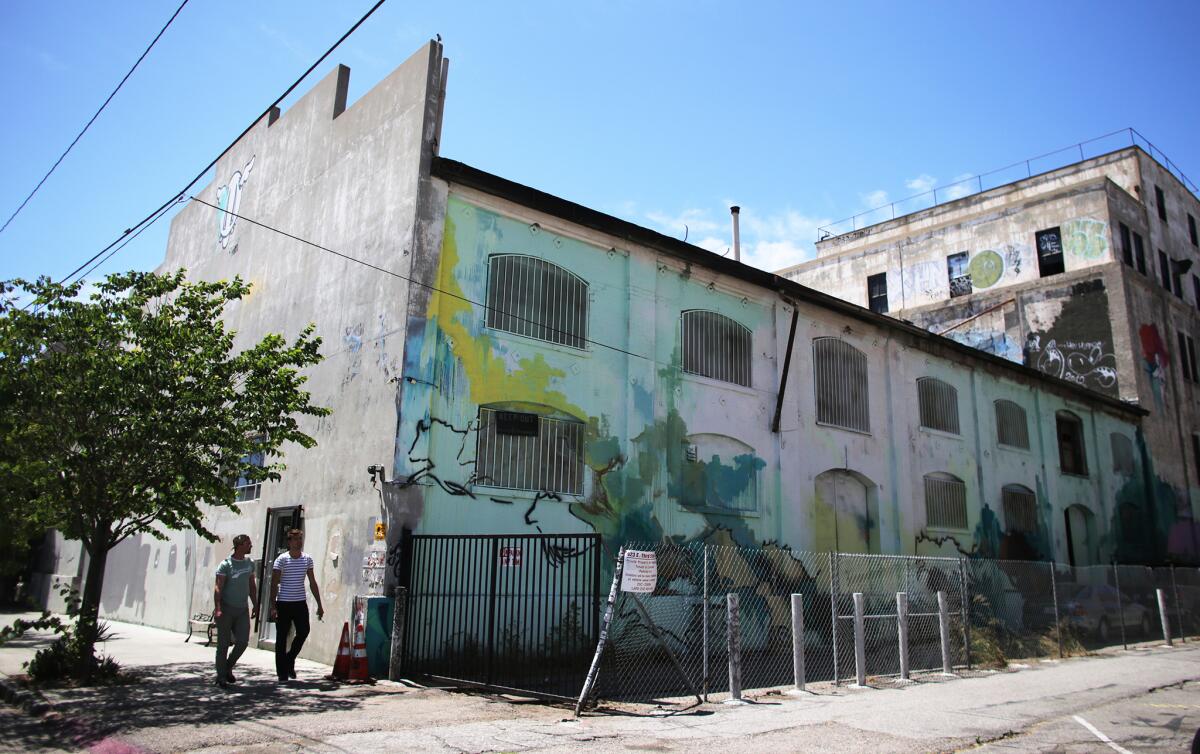Hauser Wirth & Schimmel to inaugurate L.A. gallery with exhibition of female sculptors

This downtown 19th century flour mill will house the new Hauser Wirth & Schimmel gallery. The space is set to open in March with a show of female artists.
- Share via
A historic survey of sculpture made by women in the post-World War II era will be the debut show at Hauser Wirth & Schimmel, the soon-to-open Los Angeles outpost of the Swiss blue-chip gallery, helmed in part by Paul Schimmel, the former chief curator at the Museum of Contemporary Art.
The exhibition, “Revolution in the Making: Abstract Sculpture by Women, 1947-2016,” opens March 13. It will include rare and fragile pieces by legendary artists such as French sculptor Louise Bourgeois, the German-born Eva Hesse, Brazilian Lygia Pape, Tokyo-based Yayoi Kusama, as well as Louise Nevelson, a New York artist known for her monumental monochromatic installations.
Schimmel says the exhibition is inspired by the personal collection of gallery founder Ursula Hauser. It contains a number of pieces by significant female artists.
-----------
FOR THE RECORD
9:28 a.m., Nov. 23: An earlier version of this article said Ursula Hauser is a gallery partner. She is no longer a partner at Hauser & Wirth.
-----------
“I come from the museum world, where it’s always best to start with what’s in a collection, with the history of an institution and build out from there,” says Schimmel. “This came from a real personal recognition that these are artists who [Ursula] deeply related to, but were under-appreciated.”
The show will feature more than 100 works by almost three dozen female artists from all over the world. And it will occupy all of the exhibition areas at the 19th century flour mill on East 3rd Street downtown that will house Hauser Wirth & Schimmel. The sprawling complex checks in at about 100,000 square feet.
“One of the real pleasures of the building is the space,” says Schimmel. “In any other space, I could have just focused on the ‘50s or the ‘60s or the ‘80s, or I could have just done new artists. But this will allow us to bring this extraordinary history together in a broadly revisionist way.”

Paul Schimmel, who served as MOCA’s chief curator for more than two decades until 2012, will make his L.A. comeback as a partner in Hauser Wirth & Schimmel, the California outpost of the international Swiss gallery juggernaut Hauser & Wirth.
The decision to feature all women comes at a time when questions of gender parity have been simmering in the art world. Regular tallies conducted by artists such as the Guerrilla Girls activist collective and L.A. conceptual artist Micol Hebron show that women remain consistently underrepresented in the commercial gallery sphere.
“Sculpture, in particular, is one of the last bastions of exclusion for women,” says Jenni Sorkin, a specialist in feminist art who is co-curating the exhibition. “Bourgeois and Nevelson are considered huge pioneers in sculptural practice — and not only in their content, but as women who had to muscle their way into sculpture at a time when it was really not friendly to them.”
As part of the show, the gallery will feature important 20th century California artists as well, such as Ruth Asawa and Claire Falkenstein. Falkenstein, who died in 1997, was a Los Angeles-based artist known for her “welding techniques and her pioneering work with wire,” says Sorkin.
Asawa was a Japanese American artist who spent World War II in an internment camp. After the war, she studied at Josef Albers’ highly influential Black Mountain College in North Carolina. The artist was the subject of a traveling retrospective at the Japanese American National Museum in 2007, but she remains under-recognized for her innovations.
“She made these wonderful looped wire sculptures that are an extension of basket-like forms and repetition,” says Schimmel. “We will have the largest work she ever made: a 21-foot-long sculpture that came out of a museum in Utah.”
The exhibition will feature other rarities as well: a pair of 1960s pieces by Hesse that have not been seen together since they were first exhibited by renowned New York dealer Leo Castelli in the late 1960s, as well as early works by Bourgeois, dating back to the 1940s.
These are major works, not easy baubles to walk away with.
— Paul Schimmel, on Hauser Wirth & Schimmel’s debut exhibition
There will be contemporary installations too — including a site-specific piece by New York artist Shinique Smith and works by noted Los Angeles sculptors Kaari Upson, Liz Larner and Rachel Khedoori.
For Schimmel, the show represents his long-awaited Los Angeles curatorial comeback after his controversial departure from MOCA in 2012, then under the directorship of Jeffrey Deitch. And though the comeback is in a commercial gallery space, he is nonetheless taking a thorough, museological approach.
“These are major works,” he says, “not easy baubles to walk away with.”
“Revolution in the Making: Abstract Sculpture by Women, 1947-2016” will open at Hauser Wirth & Schimmel, 901 E. 3rd St., Los Angeles, hauserwirthschimmel.com.
Find me on Twitter @cmonstah.
More to Read
The biggest entertainment stories
Get our big stories about Hollywood, film, television, music, arts, culture and more right in your inbox as soon as they publish.
You may occasionally receive promotional content from the Los Angeles Times.











